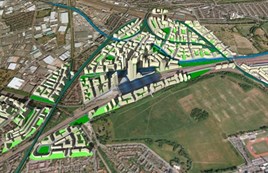"Our objective is for HS2 to stop at Old Oak Common. I don’t know entirely where Old Oak Common is, but it is a jolly good place for a train to stop. That is my view of Old Oak Common.”
So said anti-HS2 agitator Stanley Johnson, father of current Mayor of London Boris. He was speaking at a public meeting in 2014 against the proposals for HS2 - and in particular the plan for a complete redevelopment of Euston and a large-scale widening of the railway’s approach to it, in order to accommodate the additional tracks.
Until very recently, unless you lived and worked in the vicinity, you had worked on the railway or you were an enthusiast, you had probably never heard of Old Oak Common. It was that magical, faraway place between Harlesden and Acton where railway-related things happened, but not much else.
And pass by this otherwise unremarkable part of West London on the Great Western Main Line, and the one thing you certainly won’t see is gnarled, aged oak trees surrounded by green pastures. But as a railway centre it has always been important.
Old Oak Common is home to a number of railway depots, most famously dating back to steam days but also more recently the former Eurostar depot known as North Pole.
Today it is a crucial maintenance hub for pretty much every train that runs into and out of Paddington - from the long-distance High Speed Trains operated by First Great Western to the airport electric multiple units for Heathrow Express/Connect, the Class 180 Adelante diesel multiple units for FGW and open access operators, the Night Riviera Sleeper stock and Thames Turbo DMUs for local and regional trains.
It has also been used recently as a temporary base for the storage of Crossrail’s tunnel segments for transporting to the Royal Oak portal site.
Even so, much of this vast, expansive swathe of railway land is currently redundant. But that is about to change, with Old Oak Common set to grow in importance over the next 15 years.
The site has been repurposed as a key maintenance depot for the Intercity Express Programme Class 800/801 fleet with effect from later this year, while a planned station and ‘super hub’ will place the area at the heart of rail connectivity.
Regeneration is a huge part of why Old Oak Common has been selected for redevelopment. The area sits across three London boroughs (Hammersmith & Fulham, Ealing and Brent), with land at Hammersmith & Fulham identified as a regeneration area within the borough’s Local Plan. And the planned station and ‘super-hub’, with an integrated package of local transport investment, is envisaged to attract a potential 19,000 new homes and 90,000 jobs.
High-level assessment of the capacity, phased over a 30-year period, has shown that the planned level of development around Old Oak Common could release substantial economic value, generating a GVA (Gross Value Added) of approximately £50 billion, and a GVA to the specific London economy of £5.6bn. The GVA for the wider UK economy could be as much as £4.3bn, while the Treasury could reap £1.6bn in taxes. Council tax revenue for local authorities could contribute £16 million every year.
The area around the station interchange - North Acton and Willesden Junction (Old Oak North) - is envisaged to be largely residential, with a commercial hub around the HS2 station.
More broadly, the wider Park Royal industrial area (described as ‘London’s bread basket’ because of its crucial role in providing sandwiches to nearby Heathrow) could have its existing focus enhanced. The proposed Old Oak Common Mayoral Development Corporation expects that industrial, waste or commercial uses displaced from the ‘core sites’ could potentially be relocated to the main industrial area.
Aside from the proposals to develop this large swathe of industrial land between Old Oak Common Lane, Wormwood Scrubs, Scrubs Lane and Willesden Junction, Johnson Senior is correct - Old Oak Common will be a future station.
It is expected to open in 2026 and will serve HS2 (which will rise up from a tunnel underneath central London), the Great Western Main Line (including Crossrail) and the London Overground network. New platforms are planned for the northerly part of the area (part of Willesden Junction, adjacent to the West Coast Main Line).
It has been described as West London’s answer to Stratford, and the similarities are clear.
But as an interchange, Old Oak Common has the potential to be considerably more important than any other station in London (perhaps even Euston) as southern England’s main high-speed hub railway station. It could even end up being more important than other historic central London rail termini, in that the North of England, the East and West Midlands, North and South Wales, the whole of the West Country and many parts of London will be considerably more accessible.
Good connections will also be available from Crossrail trains calling at Old Oak Common that will terminate on the extremities of East Anglia and Kent. And Scotland’s principal cities may well be added to that list when HS2 plans develop in the 2020s and 2030s.
After a contract between Transport for London and Bombardier was signed in February 2014, covering the supply and delivery of 65 new Bombardier trains for Crossrail, the way was paved for the Old Oak Common depot to be constructed - with Bombardier also responsible for the trains’ maintenance.
After it is built, the depot will be the sole maintenance facility for the Crossrail fleet, and will be used to stable 33 trains during the night. They will be cleaned and maintained in readiness for the start of service the following day.













Comment as guest
Comments
No comments have been made yet.